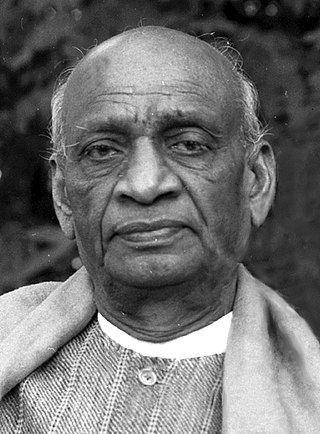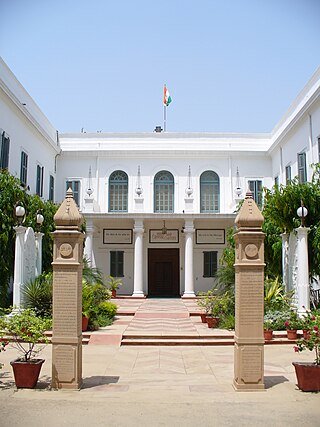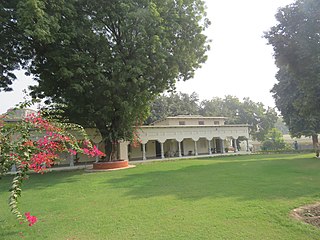Related Research Articles

Jawaharlal Nehru was an Indian anti-colonial nationalist, statesman, secular humanist, social democrat, and author who was a central figure in India during the middle of the 20th century. Nehru was a principal leader of the Indian nationalist movement in the 1930s and 1940s. Upon India's independence in 1947, he served as the country's first prime minister for 16 years. Nehru promoted parliamentary democracy, secularism, and science and technology during the 1950s, powerfully influencing India's arc as a modern nation. In international affairs, he steered India clear of the two blocs of the Cold War. A well-regarded author, his books written in prison, such as Letters from a Father to His Daughter (1929), An Autobiography (1936) and The Discovery of India (1946), have been read around the world.

Vallabhbhai Jhaverbhai Patel, commonly known as Sardar Vallabhbhai Patel, was an Indian independence nationalist and barrister who served as the first Deputy Prime Minister and Home Minister of India from 1947 to 1950. He was a senior leader of the Indian National Congress, who played a significant role in the country's struggle for independence and its political integration. In India and elsewhere, he was often called Sardar, meaning "Chief" in Hindi, Urdu, Bengali and Persian. He acted as the Home Minister during the political integration of India and the Indo-Pakistani War of 1947.

Chanakyapuri is a neighbourhood and diplomatic enclave established in the 1950s in New Delhi, India. It is also a sub-division of the New Delhi district and plays host to the majority of foreign embassies in New Delhi. Chanakyapuri, meaning "city of Chanakya", is named after Chanakya, an ancient Indian diplomat, philosopher, politician, military strategist and advisor to Maurya Emperor Chandragupta Maurya.

The University of Allahabad is a Public Central University located in Prayagraj, Uttar Pradesh, India. It was established on 23 September 1887 by an act of Parliament and is recognised as an Institute of National Importance (INI). It is one of the oldest modern universities in India and also Known as “Oxford of East”. Its origins lie in the Muir Central College, named after Lt. Governor of North-Western Provinces Sir William Muir in 1876, who suggested the idea of a Central University at Prayagraj, which later evolved to the present university. It was known as the "Oxford of the East". Its Central University status was re-established through the University of Allahabad Act 2005 by the Parliament of India.

Gandhi Smriti, formerly known as Birla House or Birla Bhavan, is a museum dedicated to Mahatma Gandhi, situated on Tees January Road, formerly Albuquerque Road, in New Delhi, India. It is the location where Mahatma Gandhi spent the last 144 days of his life and was assassinated on 30 January 1948. It was originally the house of the Birla family, Indian business tycoons. It is now home to the Eternal Gandhi Multimedia Museum, which was established in 2005.

Purushottam Das Tandon was a freedom fighter from Allahabad, Uttar Pradesh, India. He is widely remembered for his opposition to the partition of India, as well as efforts in achieving the Official Language of India status for Hindi. He was customarily given the title Rajarshi. He was popularly known as UP Gandhi. He was awarded the Bharat Ratna, India's highest civilian award, in 1961.

The Indian National Congress was established when 72 representatives from all over the country met at Bombay in 1885. Prominent delegates included Dadabhai Naoroji, Surendranath Banerjee, Badruddin Tyabji, Pherozeshah Mehta, W. C. Banerjee, S. Ramaswami Mudaliar, S. Subramania Iyer, and Romesh Chunder Dutt. The Englishman Allan Octavian Hume, a former British civil servant, was one of the founding members of the Indian National Congress.

Swaraj Bhavan is a large mansion located in Prayagraj, India, best known for once being owned by the Indian political leader Motilal Nehru and being home to the Nehru family until 1930.
George Town is an upper-class neighbourhood locality in Prayagraj, India. Built in 1901, it is a residential area in the central part of the city mainly occupied by the white collar workers. It also houses a large number of hospitals and clinics. Georgetown is famous for is affluent surroundings and apartments. It is bordered by Kamla Nehru Road in the west, Thornhill Road, MG Marg in the south and Tagoretown in the west. Park Road, Lowther Road and Hamilton Road runs through the neighborhood.
Chowk is a neighborhood in Prayagraj, Uttar Pradesh, India. It is the historic city centre of Old Prayagraj. It is one of the oldest & largest business markets of India & lies in old Prayagraj. The landmark of this market is historic Prayagraj Clock Tower, built in 1913, also known as Chowk Ghantaghar.

Naini is a satellite neighborhood and a twin city of Prayagraj in Prayagraj district, Uttar Pradesh, India. By the 1950s Naini was established as the chief industrial area of the city.
The Old Prayagraj City, at the south of Prayagraj Junction Railway Station, consists of neighborhoods like Chowk, Johnstongunj, Dariyabad, Khuldabad etc. and was in existence from the time of Akbar. Some magnificent structures erected in this era consist of the Khusro Bagh and the Allahabad Fort. In the north of Railway Station, the New Prayagraj City consists of neighborhoods like Lukergunj, Civil Lines, Georgetown, Tagoretown, Bharadwaj Puram, Ashok Nagar, Mumfordgunj etc., which are relatively new and were built during the British rule. These neighborhoods reflect British architecture like the All Saints Cathedral, Alfred Park and Allahabad High Court. Newer residential areas include neighborhoods like Kareli and suburbs like Naini Jhunsi and Manauri bajar.

Prayagraj, also known as Ilahabad or Allahabad in an anglicized version in Roman script, and anciently Prayag, is a city situated on an inland peninsula, surrounded by the rivers Ganges and Yamuna on three sides, with only one side connected to the mainland Doab region, of which it is a part. This position is of importance in Hindu scriptures for it is situated at the confluence, known as Triveni Sangam, of the holy rivers. As per Rigveda the Sarasvati River was part of the three river confluence in ancient times. It is one of four sites of the Kumbh Mela, an important mass Hindu pilgrimage.

Prayagraj, formerly known as Allahabad or Ilahabad, is a metropolis in the Indian state of Uttar Pradesh. It is the administrative headquarters of the Prayagraj district, the most populous district in the state and 13th most populous district in India and the Prayagraj division. The city is the judicial capital of Uttar Pradesh with the Allahabad High Court being the highest judicial body in the state. As of 2011, Prayagraj is the seventh most populous city in the state, thirteenth in Northern India and thirty-sixth in India, with an estimated population of 1.53 million in the city. In 2011, it was ranked the world's 40th fastest-growing city. The city, in 2016, was also ranked the third most liveable urban agglomeration in the state and sixteenth in the country. Hindi is the most widely spoken language in the city.

The Allahabad Museum is a national-level museum in Prayagraj, Uttar Pradesh. Established in 1931, it is known for its rich collection and unique objects of art, and is funded by Ministry of Culture. Moreover, it is a premier research centre for archaeologists, historians and academicians and carries out extensive research activities and publications in archaeology, art and literature. Its rock art gallery has the largest collection of prehistoric paintings displayed in India dating from 14,000 B.C to 2000 B.C. The museum, using solar power system, has become the first museum in the country to become self-reliant in power generation. The Allahabad Museum is centrally located in the Civil Lines area of the city in a lush green garden at Chandrashekhar Azad Park, popularly known as Company Bagh. It is about 3 km away from the Allahabad railway junction and almost equidistant from three different Railway Stations such as Prayag, Rambagh and Prayagraj junction and about 12 km away from Prayagraj Airport.

All Saints' Cathedral, also known as Patthar Girja, is a United Protestant cathedral located in Prayagraj, India; it belongs to the Church of North India.
MG Road or Mahatma Gandhi Road formerly known as James Street is one of the busiest roads of the city of Indore and a foremost shopping district in the city. It is spread over 8.6 km. Starting from Devi Ahilyabai Holkar International Airport it leads to the life line of city i.e. A.B. Road on Palasia Square. Major landmarks include Indore High Court, Regal Square, Gandhi Hall, Treasure Island, Chhappan Dukaan, Jail Road, Kothari Market, Rajwada and Khajuri Bazaar.

Sansad Marg is a street located in New Delhi, India. The street gets its name from the Parliament House.
References
- ↑ "Google Maps". google.co.uk.
- ↑ "Allahabad". Google Maps. Retrieved 28 February 2015.
- ↑ "Bungalows where Kipling, Tagore stayed lie neglected | Allahabad News - Times of India". The Times of India . 31 May 2014.
- ↑ "286cr, 23 projects for city's dev | Allahabad News - Times of India". The Times of India . 3 September 2015.
- ↑ "INTRODUCTORY NOTE On the High Court of Judicature at Allahabad" (PDF). allahabadhighcourt.in. Retrieved 12 September 2013.
- ↑ Jonathan M. Bloom, Sheila Blai (2009). The Grove Encyclopedia of Islamic Art and Architecture, Volume 3. Oxford University Press. p. 57. ISBN 978-81-250-1383-9.
- ↑ Henry George Keene (2000) [1875]. A Hand-book for Visitors to Lucknow: With Preliminary Notes on Allahabad and Cawnpore. J. Jetley. pp. 14–15. ISBN 81-206-1527-1.